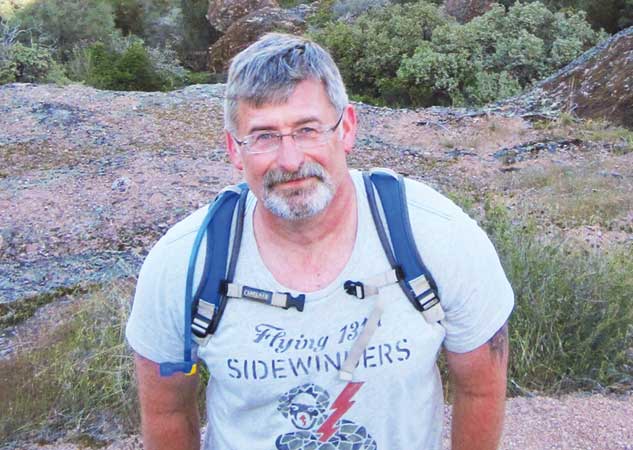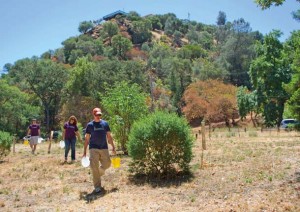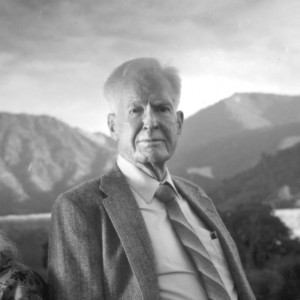Seth Adams is a big-picture guy, but he also revels in the details: the details of wildflowers, the details of maps, the details of building a trail or building a coalition. Perhaps that’s why he’s so effective as land programs director at Save Mount Diablo (SMD). In his 25 years on the job, Seth has helped SMD grow into a major force for conservation in the East Bay: Since 1988, the organization has aided in the preservation of more than 100,000 acres of open space in eastern Alameda and Contra Costa counties, through advocacy, direct purchase, stewardship, and education. An avid hiker, cyclist, natural historian, and weight lifter, Seth is quick to credit his colleagues at SMD, and particularly Executive Director Ron Brown, for the organization’s success.
BN: Where did you grow up, and how did you relate to nature as a kid?
SA: I’m an army brat, so I moved around a lot – Florida, Mississippi, Texas, Italy, Germany. But my dad did four tours in Vietnam so we got to stay in North Carolina for a while. North Carolina is incredibly rich – shoreline, mountains, and lots of habitats in between – and I was in the thick of it, collecting everything that moved and even things that didn’t. I guess I’m making up for that karmically with the rest of my life!
In my family it was basically “Get out of here, go play,” and we had woods with all kinds of bogs and creeks outside our back door, and a couple of miles up the road from us were ponds with carnivorous plants and more bogs. I was a collector of animals practically from birth and when I was eight my family gave me the garage to get my animals out of the house – I had aquariums and terrariums and Styrofoam coolers with glass plates on top. We went to the shoreline every summer for a few weeks where I decimated tidepools by collecting every living creature and bringing them back to my house.
And I was stuck on endangered species and helping nature from an early age. I was all about drawing maps of islands I populated with endangered animals and plants, which is kind of ironic because if you look at what I do now, it is all about putting together puzzle pieces of individual parcels to protect large habitats – not that much different from what I did as a six-year-old, just a little more effective. I knew at a very early age that I was going to come to Berkeley and work with David Brower, and I did both those things!
BN: How did you get to work with David Brower?
SA: I was really drawn to his work and to California, even though I had never been here. And so I came out to Berkeley in December 1981, sort of against the wishes of my parents, with $400 in my pocket. The first week I was here, I started working on the campaign against the Peripheral Canal in the Delta. I just walked into the Friends of the Earth office and said I wanted to volunteer. It was nothing formal. But I’ve just always had tremendous confidence that I could do whatever I wanted to and I would just bull my way into things.
BN: How did you become involved with Save Mount Diablo?
SA: One of my best friends was photographer Bob Walker and he was on the board of Save Mount Diablo, and in 1988 they were getting ready to hire their first staff person. I applied and luckily I was hired. The board president at the time was Bob Doyle, who’s now General Manager of the East Bay Regional Park District, so we still get to work together. It was the perfect fit because it was kind of virgin territory and I could start all kinds of new efforts.
My Berkeley friends told me flat out that Contra Costa was a lost cause. But I actually thought there was far more potential out here than on the Bay side, where people were fighting over tiny things, while out here it was thousands of acres and reservoirs and landfills and things like that. Save Mount Diablo was a good fit for me because it was an organization that was interested in acquiring and saving land but they had started as an advocacy organization. And right away in my first year I was in the middle of a whole bunch of big development fights. Save Mount Diablo has been able to preserve more land through advocacy and mitigation for development than through direct acquisition – tens of thousands of acres. With our allies, especially the East Bay Regional Park District, we’ve more than doubled the amount of preserved land in Contra Costa and eastern Alameda in the last 25 years.
And now we’ve begun the next effort, which is restoration and stewardship. In the past, we acquired properties and transferred them to public agencies. But as the state has become more dysfunctional, we’ve gone from owning one or two parcels to owning 18 or 19, so we’ve had to learn a lot more about managing properties. As David Brower used to say, the next century is going to be all about restoration, and well, we’re in the next century.
BN: What’s your approach to working with landowners who have land you want to protect?
SA: People say I’m kind of stern and intimidating. But I try to be honest and credible and as straightforward as possible. This 110,000 acres that we’ve helped piece together around Mount Diablo has involved thousands of negotiations and Save Mount Diablo is famous for its unusual relationships. Relationships matter. You don’t burn bridges, even if you disagree with someone, because you’re going to be dealing with them again. I have a friend who’s a rancher – and a great naturalist, someone I’ve known for 30 years – and he doesn’t expect we’ll always agree on things, but he knows he can trust me and eventually his land will get preserved. But that’s going to be based on a 30-year relationship.
When I started working out here, Contra Costa and eastern Alameda were in last place in terms of protected open space acres per capita and acres overall in the Bay Area, except for San Francisco, and we moved up the charts some by more than doubling the amount of preserved land out here. What we say is that we’re reassembling the Diablo wilderness – expanding parks, filling in big gaps, creating wildlife corridors; we’re creating a national-park-size wilderness within an hour’s drive of seven million people.




-300x199.jpg)
-300x195.jpg)